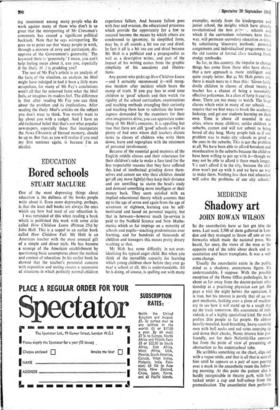Shadowy art
MEDICINE JOHN ROWAN WILSON
So. the anaesthetists have at last got into the news. Last week 3,500 of them gathered in Lon- don and they managed to throw off one or two fireworks which made the national press. We heard, for once, the views of the man at the opposite end of the table about death and re- suscitation and heart transplants. It was a wel- come change.
Usually the anaesthetist exists in the public mind as a shadowy, anonymous figure. It's understandable, I suppose. With the possible exception of the Home Office pathologist, he is about as far away from the doctor-patient rela- tionship as a practising physician can get. He pays a visit the night before the operation, it is true, but his interest is purely that of, an ex- pert mechanic, looking over a piece of machin- ery to see how it will stand up to a tough day on the track tomorrow. His assessment of indi- viduals is of a highly specialised kind. He much prefers thin people to fat people.' He abhors heavily-muscled, hard-breathing, heavy-smoking men with bull necks and red veins coursing up and down their checks. Noses interest him pro- foundly, not for their Nefertiti-like contours but from the point of view of presenting an obstruction to his endotracheal tube.
He scribbles something on the chart, slips out with a vague smile, and that is all that is seen of him until he appears as a pair of eyes peering over a mask in the anaesthetic room the follow- ing morning. At this point the patient also is hardly recognisable in theatre garb, with hair tucked under a cap and half-asleep from the premedication. The anaesthetist then performs the essential function of making sure, before in- ducing-unconsciousness, of the patient's identity. Nasty mistakes have happened in the past when the order on the operating list has been changed and the case-notes of the wrong patient have been delivered to the theatre. It is, to say the least, embarrassing to have to wake a patient up to ask him who he is.
Once identified, and linked without possibility of error to his own case-notes, the patient is given an intravenous injection of some bar- biturate drug to put him to sleep. This is not the anaesthetic itself; it is simply a method of giving a comfortable induction. You cannot give a long anaesthetic with intravenous bar- biturates, since it is impossible to exercise the necessary control. Once the patient is asleep it is possible to get on with the details of the main anaesthetic.
Nowadays there is a great variation in the methods which can be used, according to the type of operation to be performed. The basic material used to maintain the level of uncon- sciousness is some form of gas. such as nitrous . oxide, trichlorethylene, ether, or fluothane. But for a surgeon to operate effectively, a good deal more than mere unconsciousness is needed. He usually requires muscular relaxation of one degree or another. Nowadays this can be ob- tained without inducing deep anaesthesia, by the use of muscle relaxant drugs derived from curare.
For major operations it is usual to put a tube down through the larynx and feed the gas straight into the patient's lungs. This gives more accurate control of the dose administered and avoids the possibility of the patient suddenly coughing and shutting off his larynx. It also, in chest operations, enables the rate of breath- ing to be artificially controlled. The anaesthetist is able to inflate the lungs at regular intervals by using positive pressure.
From this it can be seen that the anaesthetist is something more than a straight man to the surgeon, condemned to sit meekly at the end of the table while his more flamboyant col- league throws his weight about under the bright lights. Anaesthesia nowadays is accepted as a complex and delicate physiological process which requires great skill and rigorous training. The surgeons have now and then resented this view. At the beginning of the Health Service there was some indignation when it was pro- posed to give anaesthetists consultant status equivalent to that of the physicians and sur- geons. What on earth were things coming to if a rag-and-bottle merchant was going to be paid the same as the possessor of those long, sensitive fingers? But the subsequent develop- ment of the specialty, which has been faster than that of surgery itself, has amply justified the decision. And the very high quality of British anaesthesia, which is unrivalled in the world, can be partly attributed to the status given to anaesthetists under the Health Ser- vice.
It is strange now to remember what a casual business it all used to be. Middle-aged doctors like myself can remember the time when anaesthesia was induced with a gauze mask soaked in chloroform and kept going with ether dripped from a bottle. Anybody with a medical qualification was considered competent to do this. At one hospital where I worked during the war the house surgeons used to take turns to give ear, nose and throat anaesthetics. We used to be led into a pitch-dark theatre and told to squeeze the rubber bag of the gas machine at regular intervals. There was a traditional story that on one occasion this was being done for a mastoid operation on a Yorkshire steel worker. The patient remained quite still, breath- ing steadily, while the incision was made in the skin and soft tissues. Then the surgeon got down to the mastoid and gave it a sharp crack with the chisel. The patient sat up. wide awake, and put his hand to his head. Te,' he said, in that melancholy way they have up there, `Ah wish ah'd never coom.' So much for the good old days.











































 Previous page
Previous page